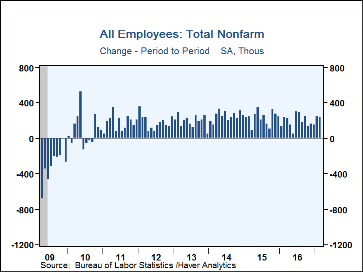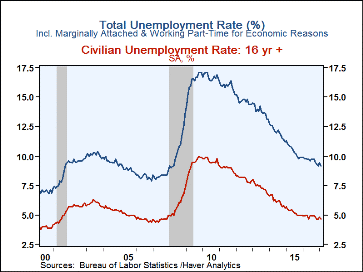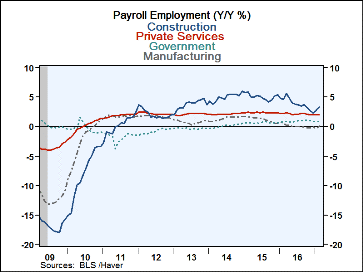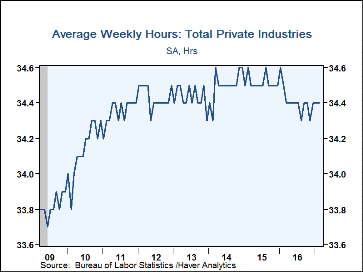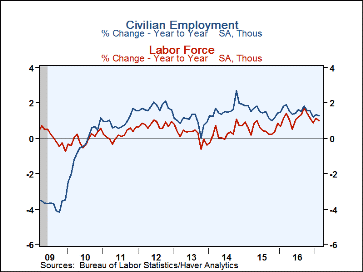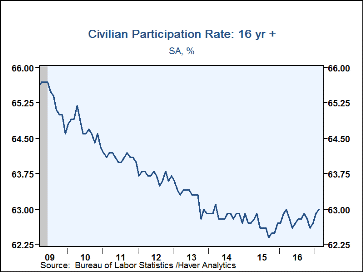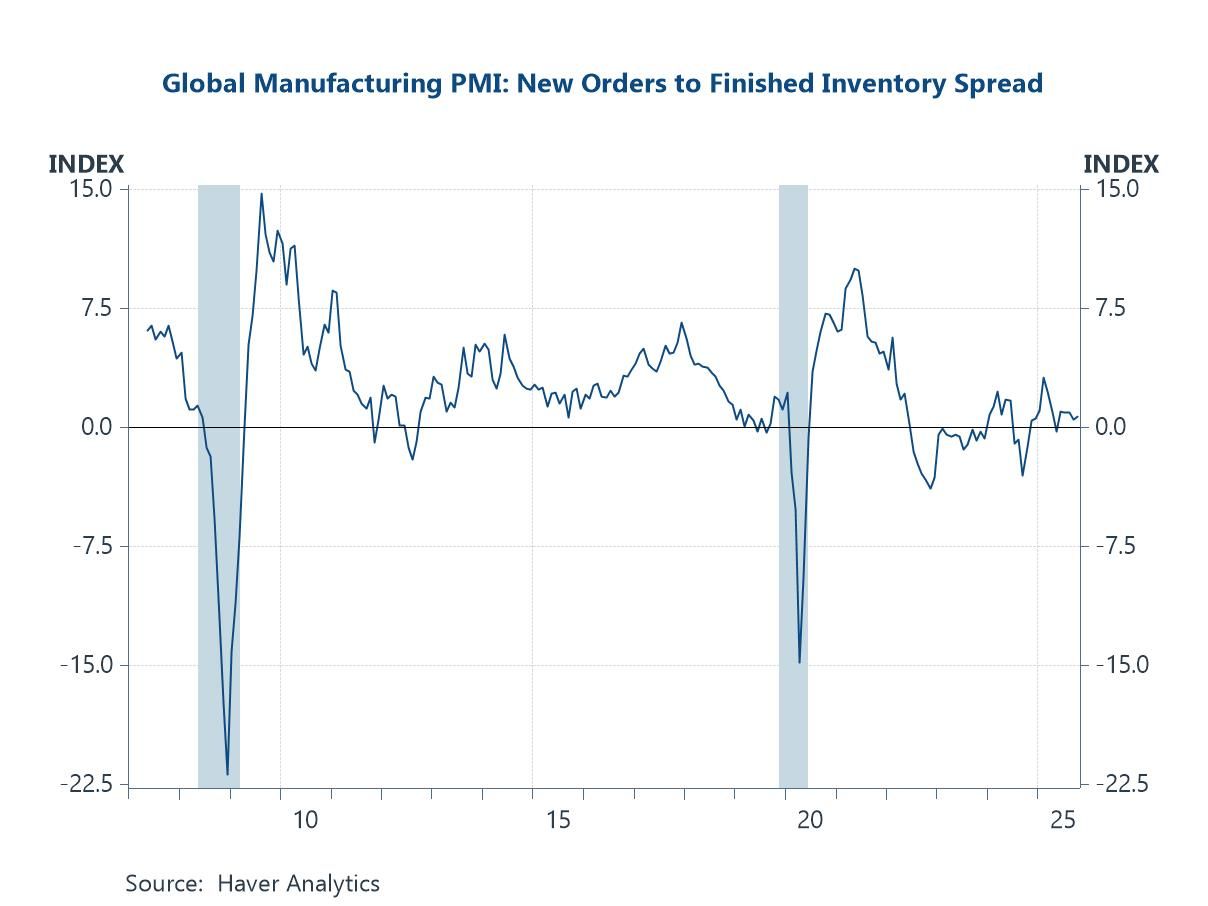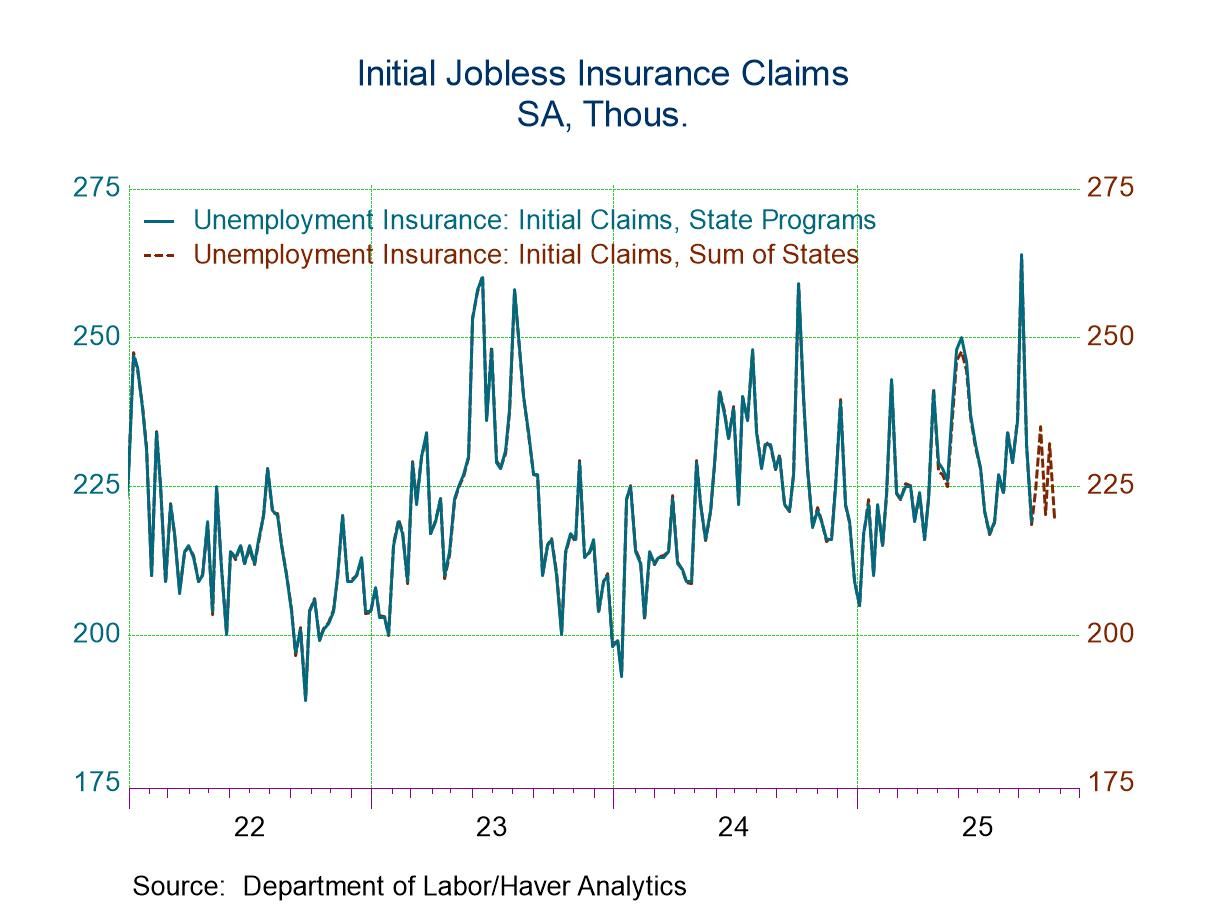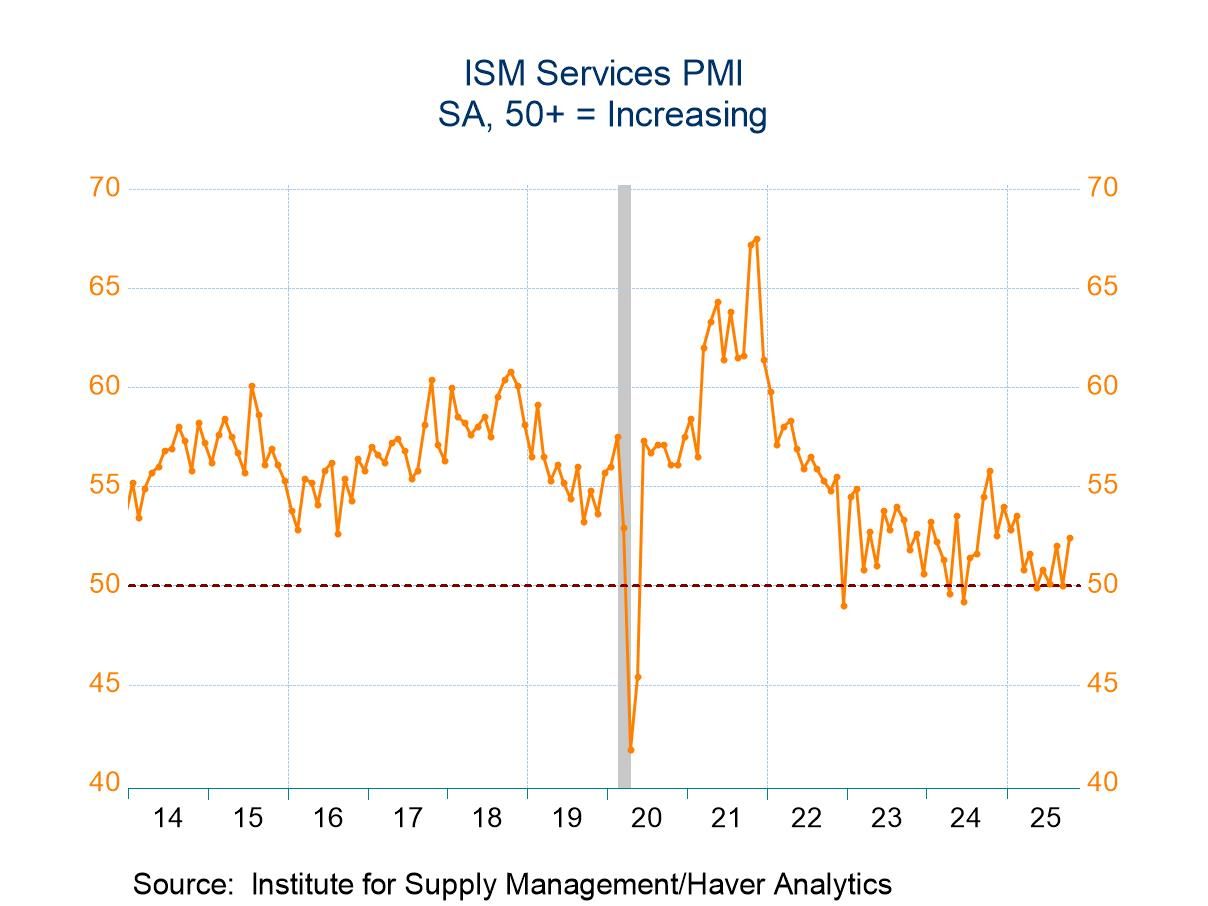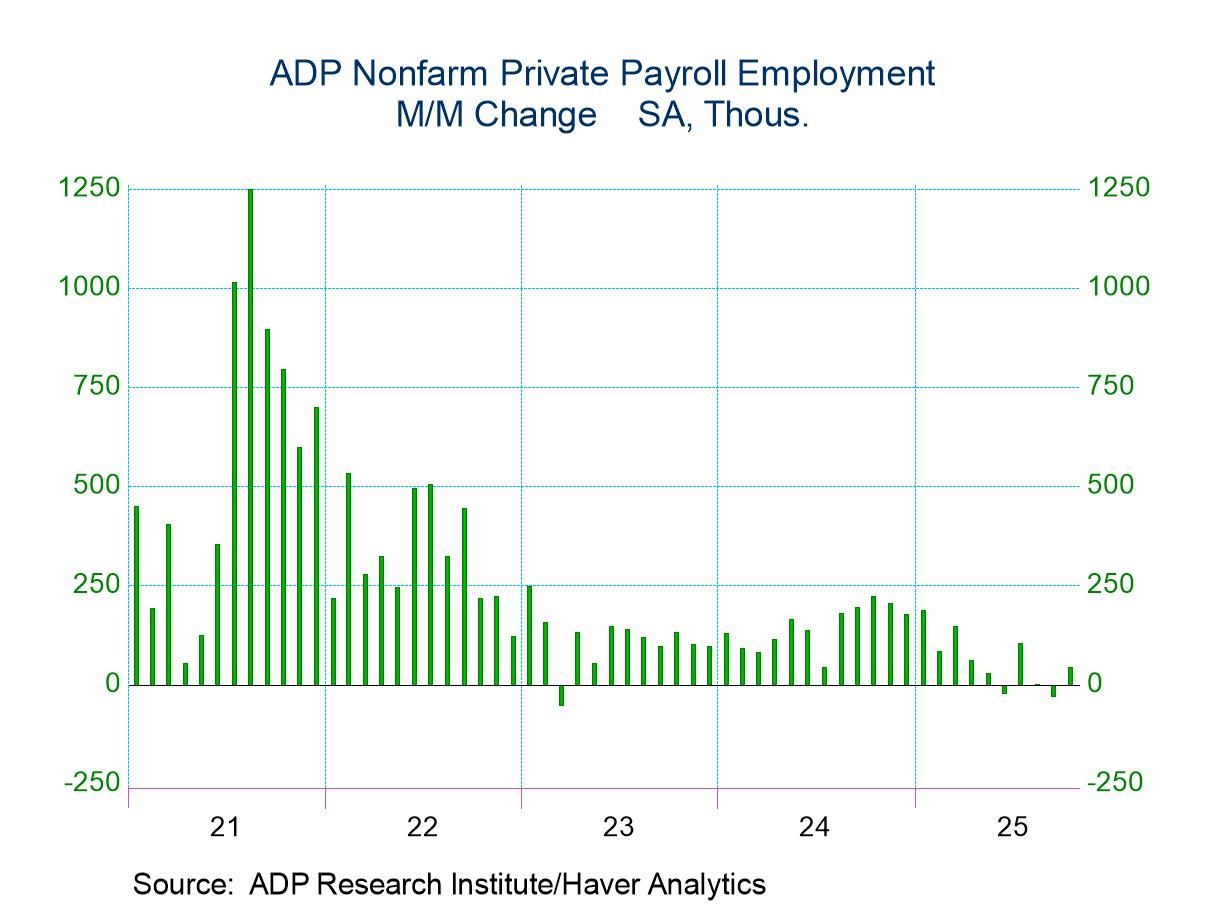 Global| Mar 10 2017
Global| Mar 10 2017U.S. Payrolls and Earnings Rise Moderately
by:Tom Moeller
|in:Economy in Brief
Summary
Nonfarm payrolls increased 235,000 (1.7% y/y) during February. The gain followed a 238,000 January rise and a 155,000 December increase. These figures together were revised up by 9,000. Expectations had been for a 196,000 increase in [...]
Nonfarm payrolls increased 235,000 (1.7% y/y) during February. The gain followed a 238,000 January rise and a 155,000 December increase. These figures together were revised up by 9,000. Expectations had been for a 196,000 increase in the Action Economics Forecast Survey. Average hourly earnings increased a steady and expected 0.2% (2.8% y/y). The unemployment rate ticked down to 4.7% from 4.8%, also as expected. The overall unemployment rate, including marginally attached workers and those working part-time for economic reasons, fell to 9.2%. The 4.5 percentage point differential between these two jobless rates has fallen from 7.1 percentage points since 2010.
From the payroll survey, the 235,000 increase in jobs reflected a 28,000 worker rise (0.1% y/y) in factory sector employment, following two months of lesser increase. Employment in the construction sector increased 58,000 (3.5% y/y), a gain likely boosted by unseasonably warm temperatures across the country. Mining sector jobs increased 7,700 (-4.1% y/y) following three months of lesser increases.
Private service sector employment rose 132,000 (1.9% y/y) following a 167,000 rise. Jobs in education & health services rose 62,000 (2.5% y/y), the strongest increase in 12 months. Professional & business service sector jobs gained a moderate 37,000 (3.0% y/y). Temporary help jobs rose 3,100 (3.2% y/y), half the prior month's increase. Leisure & hospitality employment improved 26,000 (1.9% y/y), the strongest rise in three months. Financial activities employment rose 7,000 (2.3% y/y), the weakest rise in four months. A 26,000 worker decline (+0.8% y/y) in retail trade employment offset moderate increases in wholesale trade and transportation & warehousing employment. Information services hiring remained steady (-0.3% y/y) following four months of decline.
Employment in the government sector gained 8,000 (0.9% y/y), half the prior month's increase. Local government employment rose a steady 9,000 (1.0% y/y), while federal government jobs gained 2,000 (1.5% y/y), the weakest rise in three months. State employment declined 3,000 (+0.3% y/y).
The length of the average workweek held steady at 34.4 hours, where it's been for three months. The financial activities workweek lengthened to 37.4 hours, down from 37.6 hours in 2015. The professional & business services workweek shortened slightly to 36.0 hours, but the factory sector workweek held firm at 40.8 hours. The construction sector workweek improved m/m to 39.1 hours. Aggregate hours worked (employment times hours) has risen 1.9% (AR) so far in Q1, after a 1.7% Q4 gain.
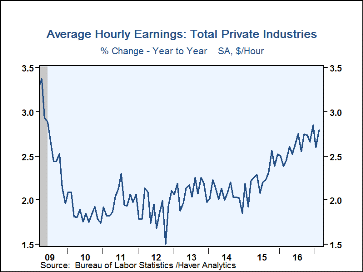 Average hourly earnings increased a steady 0.2% (2.8% y/y).
Earnings in the private service-producing sector gained 0.3% (2.8% y/y). Leisure
& hospitality earnings rose 0.2% (4.2% y/y) following two months of stronger
increase. Earnings in the information sector gained 0.2% (3.8% y/y) while
factory sector pay remained unchanged (2.9% y/y). Construction sector earnings
eased slightly (+2.7% y/y).
Average hourly earnings increased a steady 0.2% (2.8% y/y).
Earnings in the private service-producing sector gained 0.3% (2.8% y/y). Leisure
& hospitality earnings rose 0.2% (4.2% y/y) following two months of stronger
increase. Earnings in the information sector gained 0.2% (3.8% y/y) while
factory sector pay remained unchanged (2.9% y/y). Construction sector earnings
eased slightly (+2.7% y/y).
From the household sector survey, the dip in the unemployment rate to 4.7% reflected a 458,000 increase (1.3% y/y) in population-adjusted employment and a 586,000 gain (1.1% y/y) in the size of the adjusted labor force. As the size of the population rose 0.7% y/y, the labor force participation rate increased to 63.0%, the highest level since last March, and up from the 62.7% low during all of 2015. The average duration of unemployment held at 25.1 weeks, down from 39.4 weeks in 2012.
By educational attainment, the unemployment rate for workers with less than a high school diploma was 7.9%. For high school graduates with no collage, the jobless rate of 5.0% compared to 4.0% for those with less than a bachelors degree. College graduates experienced 2.4% unemployment.
Teenage unemployment of 15.0% was lower than its 25.9% peak during all of 2010. For those aged 20-24 years old, unemployment of 8.3% compared to a 15.5% high in 2010. For those aged 25-54 years old, unemployment averaged 4.1%, with a low of 3.3% for individuals aged 45-54 years old. Workers over age 55 experienced 3.5% unemployment.
The labor market data are contained in Haver's USECON database. Detailed figures are in the EMPL and LABOR databases. The expectations figure is in the AS1REPNA database.
| Employment: (SA, M/M Change, 000s) | Feb | Jan | Dec | Feb Y/Y | 2016 | 2015 | 2014 |
|---|---|---|---|---|---|---|---|
| Payroll Employment | 235 | 238 | 155 | 1.7% | 1.7% | 2.1% | 1.9% |
| Previous | -- | 227 | 157 | -- | -- | -- | -- |
| Manufacturing | 28 | 11 | 18 | 0.1 | 0.1 | 1.2 | 1.4 |
| Construction | 58 | 40 | 12 | 3.5 | 3.9 | 5.0 | 5.0 |
| Private Service-Producing | 132 | 167 | 118 | 1.9 | 2.1 | 2.4 | 2.1 |
| Government | 8 | 17 | -8 | 0.9 | 0.9 | 0.7 | 0.1 |
| Average Weekly Hours - Private Sector | 34.4 | 34.4 | 34.4 | 34.5 | 34.4 | 34.5 | 34.5 |
| Private Sector Average Hourly Earnings (%) | 0.2 | 0.2 | 0.3 | 2.8 | 2.6 | 2.3 | 2.1 |
| Unemployment Rate (%) | 4.7 | 4.8 | 4.7 | 4.9 | 4.8 | 5.3 | 6.2 |
Tom Moeller
AuthorMore in Author Profile »Prior to joining Haver Analytics in 2000, Mr. Moeller worked as the Economist at Chancellor Capital Management from 1985 to 1999. There, he developed comprehensive economic forecasts and interpreted economic data for equity and fixed income portfolio managers. Also at Chancellor, Mr. Moeller worked as an equity analyst and was responsible for researching and rating companies in the economically sensitive automobile and housing industries for investment in Chancellor’s equity portfolio. Prior to joining Chancellor, Mr. Moeller was an Economist at Citibank from 1979 to 1984. He also analyzed pricing behavior in the metals industry for the Council on Wage and Price Stability in Washington, D.C. In 1999, Mr. Moeller received the award for most accurate forecast from the Forecasters' Club of New York. From 1990 to 1992 he was President of the New York Association for Business Economists. Mr. Moeller earned an M.B.A. in Finance from Fordham University, where he graduated in 1987. He holds a Bachelor of Arts in Economics from George Washington University.


